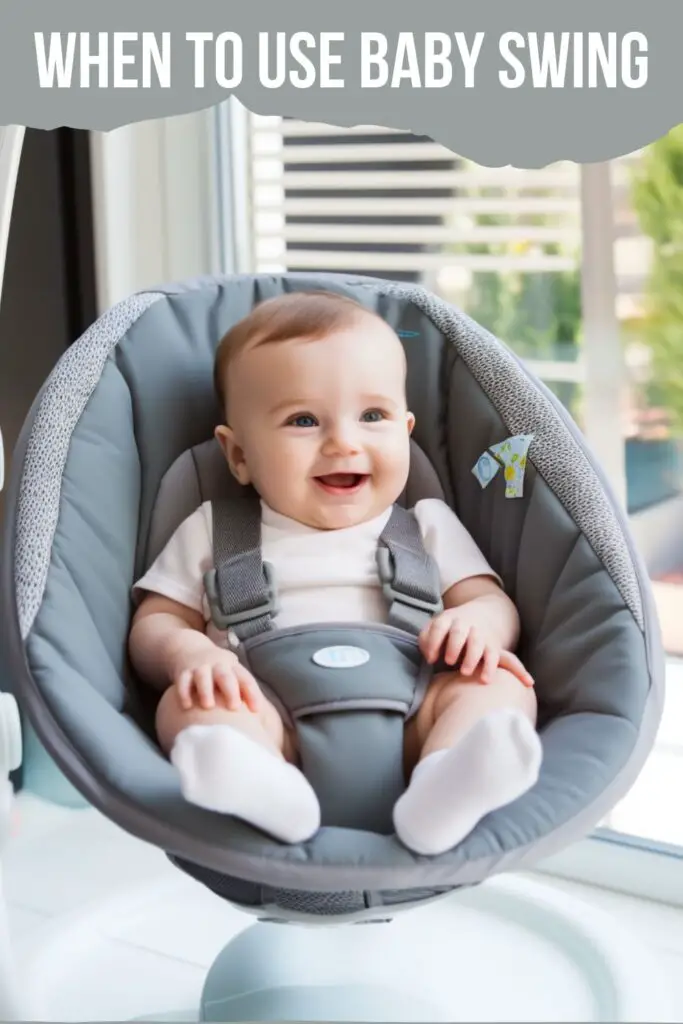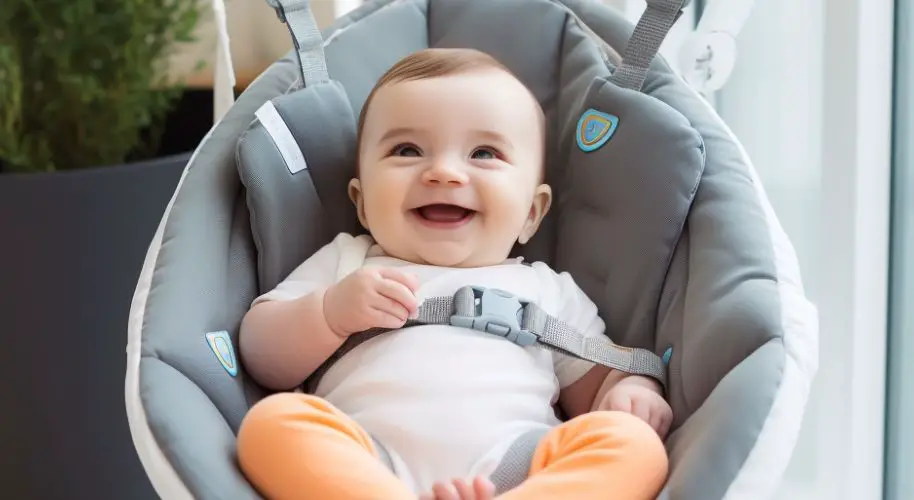Last Updated on June 5, 2025
Baby swings can be a great way to soothe and comfort your baby. Baby swings are an ideal solution when you need a break or are busy with other tasks.
They offer a safe, secure place for babies to relax and play while giving parents the freedom to do what they need to do.
In this article, we’ll discuss when to use a baby swing and some tips for finding the best one.

When to Use a Baby Swing?
Baby swings are best to support parents when used in moderation. Baby swings are for babies as a supplement to other forms of care, such as cuddling, rocking, and singing. To ensure your baby is comfortable and safe while in the swing, you’ll want to monitor them closely during use.
When To Start?
When using a baby swing, the consensus is that babies should be at least 8 or 9 months old before they can safely use one. However, some experts say it’s generally safe to start using a swing once your baby is about 4 months old and can hold their head up independently.
It’s important to remember that the American Academy of Pediatrics (AAP) cautions against leaving babies to sleep in any infant seating device, including swings. It’s best to be playful but cautious when introducing your baby to a swing for the first time.
When you decide to put your baby in a swing, ensure it is stable and sturdy, and always keep an eye on them while they are in it. If your baby is younger than 4 months, ensure the swing is in its most reclined position and never leave them unattended.
When to stop?
When it comes to baby swings, it’s important to know when to stop using them. Generally, babies will outgrow a swing when they’re 9-10 months old.
At this point, they have more upper body strength and can lean forward with their full weight, making climbing out of the swing possible.
Additionally, if your baby starts to stir in the swing, you should stop using it immediately. It’s also important to consider safety when using a baby swing. Ensure you follow all instructions carefully and keep an eye on your little one while they are in the swing.
Once your child can climb out of the swing or shows signs that they want to crawl out (usually around 9 months), you should stop using it completely.
Why Do You Need a Baby Swing?
Having a baby swing can be a great way to give new parents a break and soothe their infant. Baby swings provide back-and-forth motion, known to help settle babies, providing comfort.
They also come in different sizes and styles, making finding one that fits your needs and space easy.
Baby swings are also great for entertaining babies, as they often come with features such as music, sounds, vibration, reclining seats, and more. This can help keep your baby engaged while you take care of other tasks around the house or just relax.
Overall, having a baby swing can be an invaluable tool for any new parent looking for an easy way to soothe their infant and give themselves some much-needed rest.
Types of Baby Swings
When it comes to baby swings, there are a variety of types available. Parents have plenty of options for soothing their little ones, from traditional baby swings to electric baby swings and even bouncers.
Traditional Baby Swings: Traditional baby swings have a reclined oval-shaped seat attached to a base that moves your baby in a swinging motion. These swings usually come with features such as music, vibration, and sound to help soothe babies.
Electric Baby Swings: Electric baby swings are powered by either batteries or an AC adapter and provide more movement than traditional swings. They typically come with adjustable speeds, multiple lullabies, sound effects, and other features like removable toys and overhead mobiles.
Bouncers: Bouncers are designed for younger babies who can’t yet sit up independently. They feature a seat that bounces when the baby kicks their legs or moves around in the seat. Many bouncers also include soothing features like music and vibration to help calm babies down.
Advantages of Using a Baby Swing
Using a baby swing can offer numerous benefits for both parents and babies. Here are some of the benefits that you may experience when using a baby swing:
Reduced fussiness: Baby swings help soothe babies and reduce their fussiness by giving them gentle rocking motions and calming sounds or music. This can be especially helpful for colicky babies or those teething and having difficulty falling asleep.
Quality bonding time: When you use a baby swing, it can free up your hands so that you can focus on interacting with your little one. This helps promote quality bonding time between parent and child.
More independent play: Many baby swings come with interactive toys and activities that help babies explore their senses. This allows them to be more independent during playtime and can stimulate their minds as well.
More me time: A baby swing can offer parents a much-needed break while ensuring your little one is safe and secure. This can allow you to take a few moments and relax when needed.
Finally, baby swings are great for entertaining babies when they’re awake and alert. Most swings come with fun toys or music to keep your little one engaged and happy while you get things done around the house.
You Might also Like These Resources !
- Hanging a Baby Swing from a Tree
- Ideal Age for Baby Swings: What to Consider
- Knowing When to Stop Using a Baby Swing
Safety Tips

It’s important to use the swing safely to keep your baby safe. Here are some tips for using a baby swing safely:
- Always use the most reclined position on the swing for babies four months and under. This will help prevent them from slumping over and suffocating.
- Make sure the swing is sturdy and doesn’t tip over or fold. Check all straps and buckles to ensure they are secure before placing your baby in the swing.
- Limit your baby’s time in the motorized swing to an hour or less per day, with shorter sessions of 15 minutes or less recommended for younger babies.
- Avoid elevated surfaces when using a baby swing; always place it on the floor.
- Supervise your child while they are in the baby swing at all times.
Following these simple steps will ensure that you’re using a baby swing safely and securely for you and your little one!
Risks of Overusing the baby swing
Although baby swings can be a great way to soothe and entertain your little one, it’s important to be mindful of the risks of using them too often. Here are some potential risks of overusing a baby swing:
Risk of injury: Placing an infant in a baby swing for extended periods increases their risk of accidental injury, including falls.
Delay in development: Overusing a baby swing can inhibit your child’s ability to learn how to move independently. This may lead to a delay in gross motor skills, such as crawling or walking.
Back pain: Extended periods spent in the reclined position of a baby swing can lead to back pain and poor posture.
Reduced interaction: When babies are left in baby swings for extended periods, they miss the opportunity to interact with their parents or caregivers. This can lead to a lack of stimulation and affect their emotional development.
Therefore, monitoring your child’s time in the baby swing is important to avoid any potential risks.
FAQS
How long is it safe for a baby to be in a swing?
When it comes to baby swings, safety is of the utmost importance. It’s also important to ensure that your baby is supervised while in a swing and that they are not left unattended for long periods.
Additionally, experts do not recommend that babies sleep in a swing as this has been linked to higher risks of injury.
Can a baby swing cause flat head syndrome?
Yes, a baby swing can cause flat head syndrome if the baby spends all his day in a baby swing as the baby can’t change his lying or sleeping position in a baby swing.
Flat head syndrome, also known as positional plagiocephaly, is caused when your baby spends too much time lying on their back. This occurs not only while sleeping but also while they are in car seats, carriers, strollers, swings, and bouncy seats.
To prevent the flat head syndrome from occurring, it is important to reduce the amount of time your baby spends with their head against a flat surface when awake, including car seats, swings, strollers, and bouncy seats.
Is a baby swing safe for newborns?
Babies should not sleep in the swing as it is not designed for sleeping and could lead to suffocation or other risks. It is also important to check the weight limit of the swing before use, as most swings are designed for infants up to 40 pounds.
Lastly, it is recommended that you keep sessions short and leave your baby in the swing for at most 30 minutes at a time.
Wrapping Up
It is important to remember that baby swings are great tools for soothing and entertaining your baby, but when used in excess, they can also increase the risk of injury.
Be sure to monitor your child’s time in the swing and supervise them if they are in it for extended periods. Additionally, experts do not recommend that babies sleep in a swing as this has been linked to higher risks of injury.
Lastly, make sure that the weight limit of the swing is suitable for your baby and keep sessions short at no more than 30 minutes at a time.
Thank you for taking the time to read this article about baby swings. We hope you found it helpful and informative. As always, safety is paramount when caring for your little one.
You Might Also Like These Latest Content !
- Placing Your Baby in a Park Swing
- Simplifying Night Time Bottle Feeding: Tips and Tricks
- Are Baby Swings Secure for Newborns?


